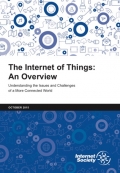 The Internet Society recently published a paper on the Internet-of-Things (IoT) which has significant implications for Deploy360 and its key technologies. The Internet of Things is the popularised term for connecting, monitoring and controlling devices such as home appliances, automobiles, industrial devices and even medical sensors over the Internet, and promises substantial technical, social and economic benefits. Aside from the privacy concerns though, there are several technical challenges to deployment where IPv6, DNSSEC, TLS and even secure routing will play a key role.
The Internet Society recently published a paper on the Internet-of-Things (IoT) which has significant implications for Deploy360 and its key technologies. The Internet of Things is the popularised term for connecting, monitoring and controlling devices such as home appliances, automobiles, industrial devices and even medical sensors over the Internet, and promises substantial technical, social and economic benefits. Aside from the privacy concerns though, there are several technical challenges to deployment where IPv6, DNSSEC, TLS and even secure routing will play a key role.
Several estimates put the number of connected devices to be upwards of 30 billion by 2020, which clearly cannot be serviced by 4.3 billion IPv4 addresses. Whilst the usable pool of IPv4 addresses has been greatly extended through the judicious use of Network Address Translation, this is not a practical long-term solution for mobile devices or those that need to be directly accessible from the Internet. Many IoT devices are also designed to be cheap and practical with processing and memory constraints that limit the use of dual IP stacks, therefore making it increasingly necessary to deploy IPv6 on the wider Internet.
Security and privacy concerns about IoT devices, especially those with sensitive or mission critical applications, will also drive the requirement for secure end-to-end connections which can be provided by TLS. In fact, it is widely recognised that encryption should be the norm for all Internet traffic (as endorsed by the IAB and ISOC statements in 2014), but the expected sheer numbers of IoT devices coupled with their highly interconnected and potentially unmonitored nature creates significant concerns for the security and resilience of the Internet globally. It will therefore become ever more important to improve all aspects of Internet security including the DNS and routing system, not just to protect IoT systems, but also to protect the rest of the Internet from compromised IoT systems.
Deploy360 will continue to follow IoT developments and how our key technologies can help support the exciting evolution towards a fully connected smart world. In the meantime, you may find the following resources useful:
- The Internet of Things: An Overview – White Paper published by the Internet Society (14 October 2015)
- The Case for IPv6 as an Enabler of the Internet of Things – IEEE Internet of Things (14 July 2015)
- IoT6.eu – European research project to investigate use of IPv6 in the Internet of Things
- Internet of Things Consortium – Industry group provides consumer research and market education aimed at driving adoption of IoT products and services
- IP for Smart Objects (IPSO) Alliance – Organisation seeking to establish IP as the basis for connecting smart objects
And if you want to learn more about the technologies we cover here, please visit our Start Here page to begin!
